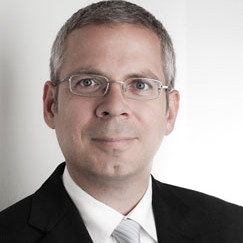In this special guest feature, ISC Big Data conference chair Sverre Jarp discusses the Internet of Things (IoT) with Dirk Slama, Director of Business Development at Bosch Software. In his keynote presentation on October 1, Slama will be focusing on how the IoT is enabling new business models and services, stressing particularly on the key success factors and present a framework that he believes will help enable that success.
Sverre Jarp: How do you think the Internet of Things (IoT) will change the way the internet infrastructure evolves?
Dirk Slama: First of all, we have to ask ourselves – how much of the Internet of Things is really going to happen in “the Internet”. Many industrial IoT applications are not going to rely on the public Internet infrastructure. They will leverage IP technologies, for sure, but they will build out their own, private network infrastructure for mission critical IoT applications such as smart grids, traffic management, and drone-based transportation networks.
However, for those IoT applications which rely on the “open” Internet, a more widespread adoption of IP v6 will be a prerequisite, given that the predictions for connected devices in this part of the IoT exceed by far the 4.3 billion unique addresses supported by IP v4.
However, just a few days ago, on August 13, we saw significant Internet outages when a large US carrier accidentally added too many new routing entries to the global routing table, exceeding the limitations of many older, IP v4 based routers. So there is still some work to be done here.
Another key aspect of internet infrastructure is time, especially many industrial IoT applications often have advanced time synchronization requirements. Today, they are relying on proprietary industry bus protocols, since current IP standards cannot meet these requirements. The IEEE initiative of “Time Sensitive Networking” promises to enhance the IP infrastructure with real-time capabilities so that it can really serve as the foundation for large IoT style mash-ups of sensors and actuators.
Sverre Jarp: What are the most critical pieces missing today that will be needed to support this sort of computational ubiquity?
Dirk Slama: Well, the Internet infrastructure I just outlined is only a small, albeit central, piece of the puzzle.
On the hardware side, we can currently foresee many interesting trends that will support the IoT, from the maker movement to the availability of hardware developer kits like Arduino and BeagleBoard, which make integrating sensors and actuators much more fun.
Another aspect of course is software development. Think back to the beginnings of the Internet, when everybody was hacking websites with CGI (Common Gateway Interface). We have come a long way in this area, with multiple generations of web application servers. The IoT is still in the CGI early days, if you like.
We are seeing some interesting ideas for IoT application middleware, both in open source as well as for commercial applications. The recent acquisition of ThingWorx and Axeda by PTC, for example, show how strategic this space is for some software vendors. The Open Service Gateway initiative (OSGi) plays an important role in the Java ecosystem for IoT, and with the RIOT operating system, iot.eclipse.org, and Contiki, we are also seeing a lot of activity in the open source community.
However, there is still some way to go before IoT application development platforms will have reached the same level of sophistication as their “normal” web application development counterparts, not to mention the big data infrastructure for processing the large streams of data we will see coming from all these sensors. There is a lot of interesting stuff happening here, like the Spark Streaming framework, which adds stream processing capabilities to Hadoop. But again, these are still the early days.
One last thing to mention here are global wireless networks. Many IoT applications rely on global wireless networks, like connected vehicle, telemedicine, etc. Most global carriers now have dedicated Machine-2-Machine (M2M) networks or at least dedicated M2M services, including device authentication, inventory management, billing, etc. M2M is seen by many as a precursor to IoT; it enables applications like remote condition monitoring, mainly via 2G and 3G networks.
However, it remains to be seen if true wireless IoT connectivity will be delivered by the incumbent carriers via their mobile-centric networks, or if alternative solutions will start playing an important role here. For example, specialized vendors like On-Ramp, Sigfox and Weightless/Neul are currently building out alternative low-power, wide-area wireless networks.
Sverre Jarp: Will it change the economic underpinnings of the Internet in regard to who pays for all the connectivity, computing and storage required by this new paradigm?
Dirk Slama: As I mentioned earlier, one question is how much of these high-volume data streams from sensor networks will really rely on the public internet infrastructure. Look at CERN, which deploys a multi-tiered architecture for capturing, filtering and reconstructing sensor data, and leverages multiple dedicated networks to do so. It’s hard to imagine data streams on this scale to be pushed over the open internet, even in an IoT scenario.
However, I believe that some of this data actually will be available in the Internet. Think, for example, of a smart city, which makes sensor data readings publicly available to foster a market for new and cool application for its citizens, like to improve traffic management, and so on. However, the question is if this will happen on a scale that threatens to seriously compete for network bandwidth with Netflix and the like. If so, then these cities will have the same discussions with the carriers as the video streaming providers have at the moment.
Sverre Jarp: Will the IoT enable new business models or new business applications?
Dirk Slama: The industry analysts are not getting tired of creating newer and larger predictions for the IoT every month. For example, Gartner now estimates that the economic value add created by the IoT will be over $1.9 trillion by 2020. I am not sure what to make of these numbers. But if I look at all the creativity both in business as well as in technology innovation in the IoT space, I am convinced that we will see many new, very large business models emerging in this space in the next 10-15 years.
And it is already happening. Look, for example, at real-time car sharing. I am a big fan of DriveNow and Car2Go in my home town, Berlin. These services are letting me select the next available car in walking distance on my smart phone. I can unlock it using a key card, use it as long as I want, and leave it wherever I want once I am finished. These cars have an on-board unit which is connected to the backend using a mobile network to access my profile.
Fortunately, they are currently limiting the functionality of these on-board units to validate my account details and control the rental process. But I am sure it will not be too long before they will monitor my driving behavior and charge me more if I abuse the car.And finally, the marketing people will discover the car renter as a captive audience and start serving customized radio, including targeted ads. Maybe they will even give me the option to use the car for free if I listen to ads non-stop while driving.
Sverre Jarp: How about the downside? Will some types of businesses just disappear?
Dirk Slama: There will be many situations where existing business models will be transformed.
Take the real-time car sharing example I just talked about. If this takes off on a large scale, it will transform the car industry for sure. Does this mean car manufacturers will disappear? No. But I am sure this will not necessarily be good news for car dealers.
As another example, take the Next acquisition by Google. If they can capitalize on the data coming from the Next thermostats and smoke detectors in a way which enables them to give the devices away for free, then sure, this is bad news for other vendors of thermostats and smoke detectors. But will everybody want Google to know when he or she is leaving home? No. And should we prevent innovation because it is potentially disrupting markets? No!
Sverre Jarp: What is your company, Bosch Software Innovations, doing to take advantage of the IoT?
Dirk Slama: We are addressing the IoT on two levels. First, we have built a platform for efficient development of highly scalable IoT applications. This platform is generic, that is, independent of a specific application domain. It uses an abstraction mechanism for devices which allows us to integrate heterogeneous devices in a very efficient way. The backend supports a central repository of all devices and assets, including their current status and past events. Leveraging our business process and business rules technology, we can implement application logic and integrate with existing enterprise applications. This platform is used both by Bosch business units as well as external customers to implement IoT applications.
Second, we have built a portfolio of domain-specific applications that leverage IoT concepts and our own IoT application platform. These applications are focusing on the areas of mobility (eMobility and fleet management), manufacturing and supply chain (Industry 4.0 and smart factory), energy (virtual power plant and smart metering), as well as smart home, smart building and smart city.
And of course we are working closely with our customers and partners to ensure that their ideas for IoT business models are supported, either by adding new capabilities to our IoT platform or to our IoT applications. As I said earlier on, we see this as a long-term opportunity, and building a vibrant ecosystem of partners and customers is a key prerequisite for business success in the IoT.
See the Dirk Slama Keynote from the ISC Big Data Conference.
Sign up for our insideBIGDATA Newsletter.






Speak Your Mind